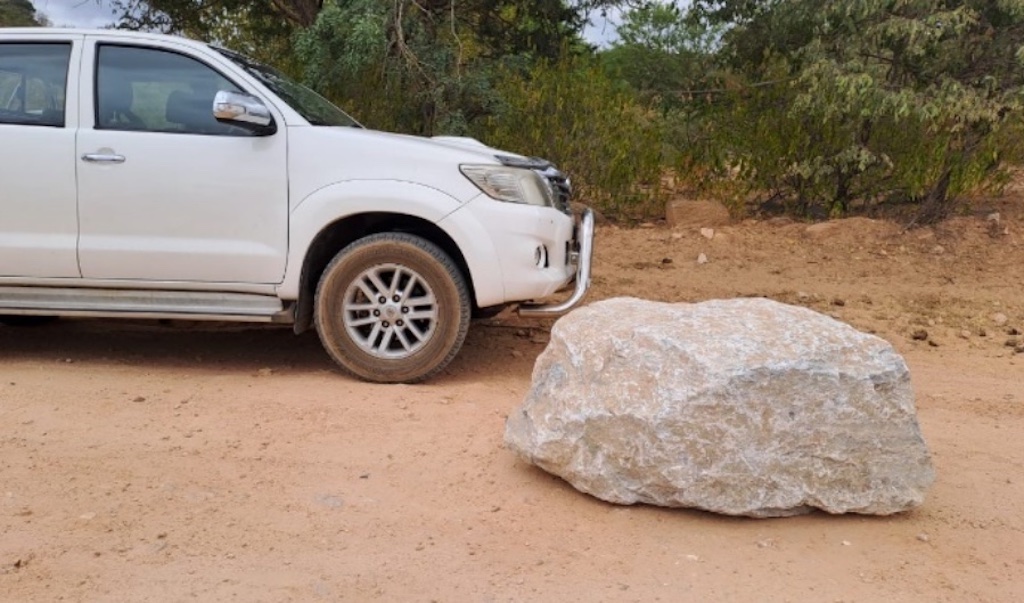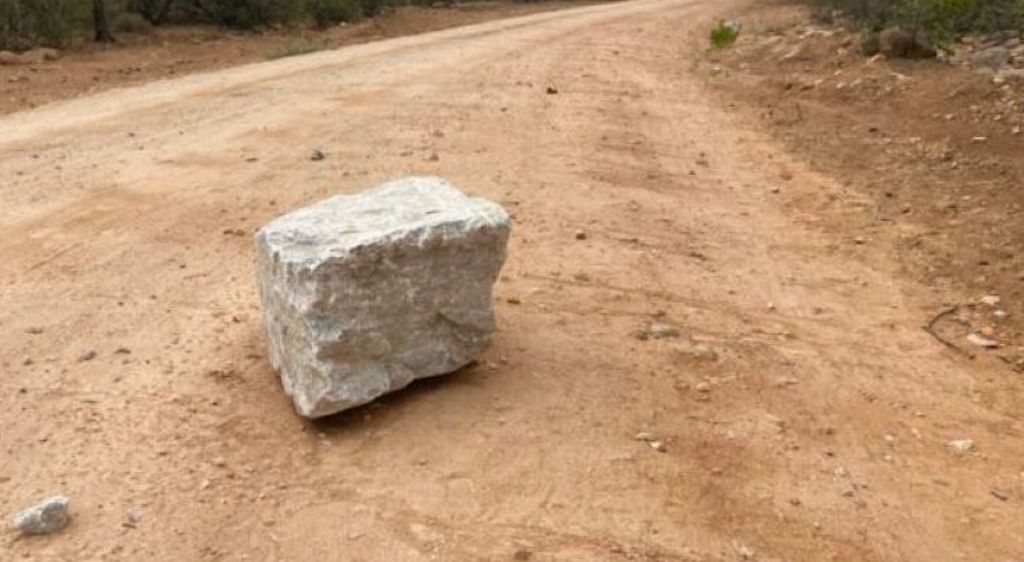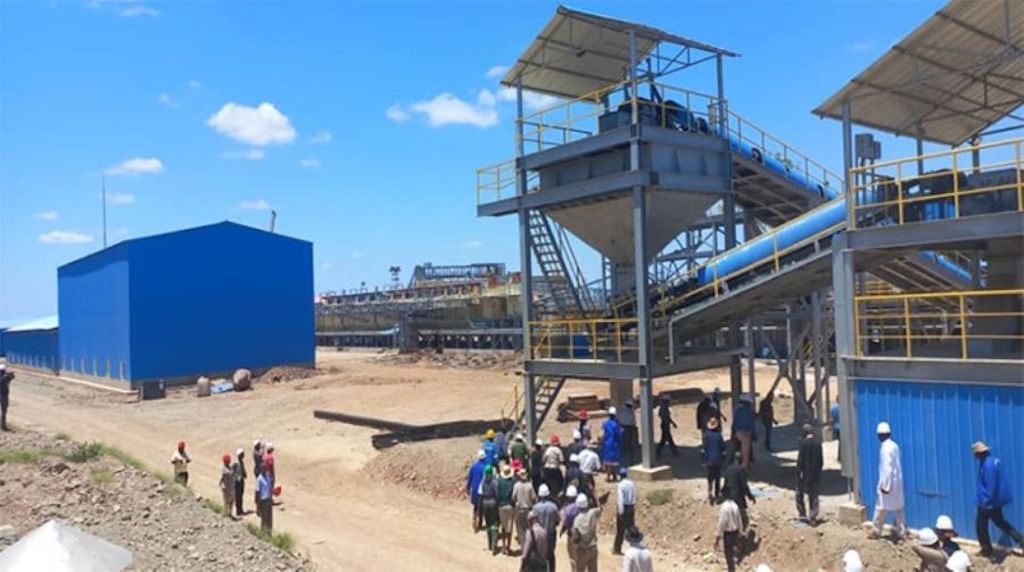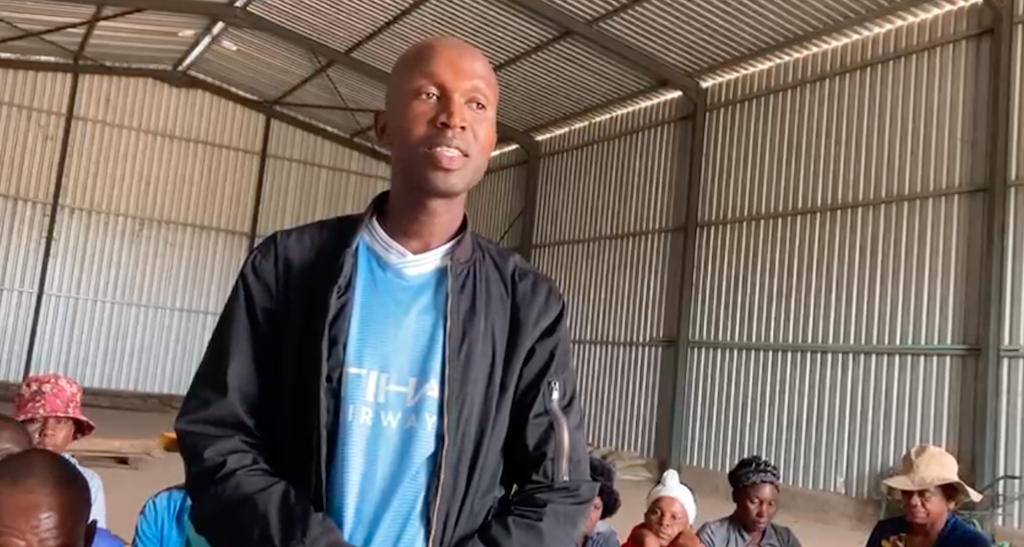
20 Sep Stuck between lithium rocks and a hard place
Zimbabwean communities living around lithium mines have to put up with noise pollution, gas emissions, dust, flying-rock hazards and ground vibrations. Oscar Nkala investigates

Flying hazard: A lithium boulder that dropped off a haulage truck on the road to Gwanda Lithium Mine in Mandihongola. Photo: GCEJDT
In the 20 years he has lived at Kafusi Growth Point, Kiepe Tsepeng could sleep peacefully until the early morning shrill of bird chatter woke him up for the new day. That ended abruptly in September 2023 when heavy trucks ferrying equipment and supplies to Gwanda Lithium Mine in Mandihongola, located about 15km north-west of Kafusi Growth Point in southern Zimbabwe, started rumbling through his village day and night.
Gwanda Lithium Mine is the reincarnation of an abandoned tin mine that yielded huge spodumene lithium deposits in 2021. Owned by Chinese company Dinson Mining Investments, the mine is one of seven new lithium mines on which the Zimbabwean government has pinned hopes of economic revival. Oxpeckers research shows that Dinson Mining Investments is a subsidiary of Tsingshan Group, a state-owned diversified mining and engineering business conglomerate in China.
Since last year, the Gwanda mine has expanded to include a processing plant that relies on the transportation of lithium ores from Mberengwa to Gwanda for processing. Kiepe Tsepeng is one of many villagers affected by the heavy dust and noise pollution caused by the passage of up to 150 heavily laden 34 tonne trucks passing by his village a day.
“There is nothing like peaceful sleep for anyone living along this road. In November last year, an average of 60 lithium trucks passed through daily. By April this year it was 200 per day, then we lost count and gave up,” he said.
“They have destroyed the roads. It is impossible for villagers to use scotch-carts [donkey-drawn transport] due to the fear of accidents. Other roads users are forced to use alternative routes to avoid this road, which is now a deadly hazard of lithium ore rocks which drop off because the loads are not secured.”
In Ntalale, villagers said their homes are now covered with the dust raised by the constant passage of heavy trucks. A health worker at Ntalale Clinic told Oxpeckers that localised dust pollution has created new chest problems, which most rural service centres are neither staffed nor equipped to deal with.
“The people are literally breathing dust. This has brought some new infections we have never seen before. Patients with pre-existing conditions like diabetes, HIV/AIDS and TB now present with persistent coughs due to the dust. We have referred many to Gwanda [Hospital] for treatment, only to be re-infected as soon as they return. It has become a vicious cycle,” said the health worker, who declined to be named because they are not allowed to speak to the media.
Villagers told Oxpeckers that the mine must be forced to tar the road to mitigate the impacts of air, dust and noise pollution. Despite being the driest, Gwanda district still produces the best cattle and goats in Zimbabwe. But cattle farmers in Gwanda South risk dropping out of the livestock producers league because the new boreholes drilled by Gwanda Lithium Mine to meet the mine’s huge water demand have drained all water sources dry.
Cattle farmer Kabelo Tlou explained: “The mine drilled 10 new boreholes down to 150m metres to ensure continuous supplies. These boreholes are far deeper than ours and have drained every other water source dry. There is no water in the dip-tanks. By monopolising access to water, the mine is killing people and livestock with one stone because livestock farming is our main source of livelihood.”

Gwanda Lithium Mine: One of seven new lithium mines on which the Zimbabwean government has pinned hopes of economic revival. Photo supplied
Confirmed impacts
In Gwanda, Oxpeckers spoke to Lungile Masuku, who is the coordinator of the Gwanda Community Economic Justice Development Trust (GCEJDT), an environmental conservation and civil rights organisation that is tracking the social and environmental impacts of the Gwanda Lithium Mine.
She said mining has caused numerous problems and strained relations with the community: “Environmental degradation, air, dust, noise and water pollution are some of the biggest challenges. The trucks which transport lithium ore from Sandawana, another mine owned by the company in Mberengwa, to Mandihongola have badly damaged the roads.”
“We have water shortages for people because the boreholes have dried up. Of late, livestock drink the raw waste water the mine releases into the dam in Mandihongola,” Masuku said.
The mine has not relocated any locals yet, but the villagers live in fear of forced evictions because no one knows whether their homes are in or outside the mining concession. In a recent report focused on the activities of Gwanda Lithium Mine, the GCEJDT said it has always struggled to meet the most basic environmental and social corporate responsibility obligations.
“Their first environmental and social impact assessment (ESIA) report, submitted to the Environmental Management Agency (EMA) for review on 18 January 2023, was rejected for a number of issues that had not been addressed. A re-submission was made on the 7th of February 2023, and they were granted an EIA certificate,” reads part of the report.
“However, the community still has complaints about the implications and health hazards of the project. They have also raised concerns around the possible exhumation of ancestral graves, a possible relocation of homesteads as well as the effects of pollution from dust, moving vehicles and noise from blasting.”
EMA officials told GCEJDT researchers that there was a high risk of mine effluent contaminating the local environment and water sources as the tailings dam at the Gwanda Lithium Mine is leaking.
According to the report, officials from the Infrastructure Development Agency (IDA), which maintains rural roads, said they were not consulted about the mine. “IDA said the mine is destroying its road network and bridges. They cited Elliot bridge over Sengezane River, Ntepe Weir and Ntalale Bridge. The IDA also complained that the mine did not consult when it repaired the road network and ended up using wrong road designs and specifications.”

Rocky road: Besides the dangers of lithium boulder debris, the transport trucks have badly damaged the roads. Photo: Photo: GCEJDT
Strategic mineral
Zimbabwe National Water Authority representatives told GCEJDT that although they were consulted during the EIA study, they could not charge the mine for violating the law because lithium is a strategic mineral that is exempted from the oversight of statutory agencies.
The representatives complained that the mine conducted unauthorised hydro-geological surveys and failed to register its boreholes, as required by the law. They said the mine’s boreholes have lowered the underground water table, forcing it to drill even deeper boreholes to supply water to the communities deprived of water by the mine.
Research for an Oxpeckers investigation in May 2024 headlined Zimbabwe’s lithium liability showed Zimbabwe is positioning itself as a global leader in mining and processing lithium, a critical transition mineral that is in demand to make batteries for phones, electric cars and solar storage, among other uses. Zimbabwe has Africa’s largest lithium reserves and is ranked as one of the top 10 countries in the world producing the soft, silvery-white ore.
“Lithium mining and processing involves open pit mining, which disrupts the landscape through overburden removal, blasting and heavy equipment,” states a study published by the African Institute for Environmental Law in April 2024, entitled Navigating Zimbabwe’s Lithium Industry.
“The lithium beneficiation process requires energy intensive grinding and flotation processes, which exacerbate environmental pollution by producing tailings with harmful chemicals. Addressing these challenges requires a detailed study of the environmental and societal impacts of lithium mining in Zimbabwe, with a focus on the well being of local communities.”
Because lithium mining involves blasting of hard rocks, communities living around lithium mines face adverse blast impacts including noise pollution, gas emissions, dust, flying-rock hazards and ground vibrations, the study notes.
Besides worsening water scarcity in host communities, the pollution of water sources by lithium mining companies remains a big problem in Zimbabwe, the study said. “It is important to emphasise that studies on lithium mining pollution acknowledge that mining hard rocks for lithium generates hazardous waste streams that contain salts, surfactants, organic extractants and solvents.”

Community concerns: Villagers discuss the destruction of their road network by mining trucks and other negative impacts of the mine. Photo: GCEJDT
Labour violations
The study says urgent legislative reforms are required to address the violation of labour laws in Zimbabwe’s lithium mining and value chains: “Labour rights violations in lithium mining companies occur directly in mining and processing operations. [They] also occur indirectly through contractors, such as construction services providers to lithium miners in Zimbabwe.”
The study also notes the human rights implications of lithium mining, saying although section 13(4) of the Zimbabwean Constitution mandates the state to ensure local communities benefit from resources in their areas, lithium host communities have gained nothing from its exploitation.
“Instead, these communities bear the negative costs of lithium mining. In Mandihongola, Gwanda, the community remembers how the old tin mine contributed to development by providing electricity and establishing a local clinic. However, the same cannot be said for the new Gwanda Lithium Mine,” it states.
Although Zimbabwean investment agreements promise employment opportunities for locals, the study found that these are rarely honoured. Some lithium miners were found to have done their environmental impact assessments without consulting local communities, and some did the studies well after mining operations commenced.
Gwanda Lithium Mine’s spokesperson, Nixon Kutsaranga, simply ignored all eight questions sent to him by Oxpeckers at his request. Efforts to get comment from Mines and Mining Development Minister Winston Chitando and Environment Minister Sithembiso Nyoni were also unsuccessful.
Oscar Nkala is a Zimbabwe-based Oxpeckers Associate who works on transnational investigations across borders in sub-Saharan Africa. This investigation is part of the Oxpeckers investigative series titled ‘The human cost of energy in Africa’.
